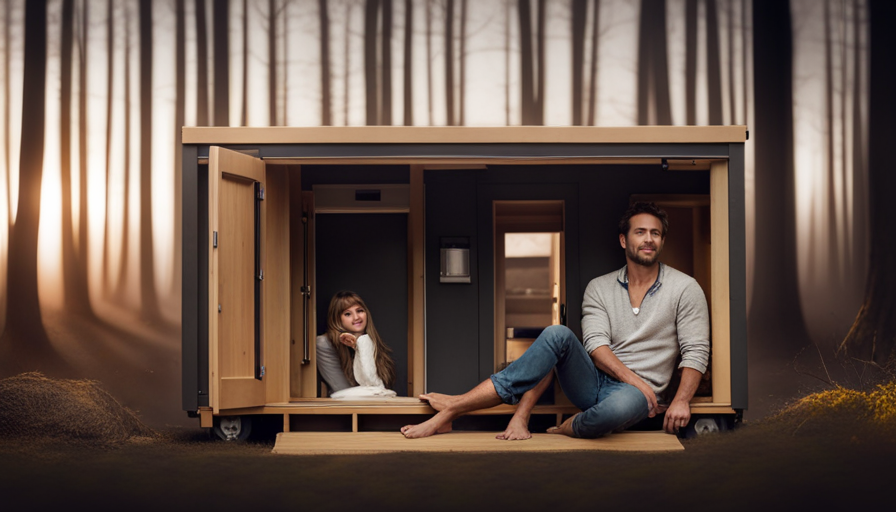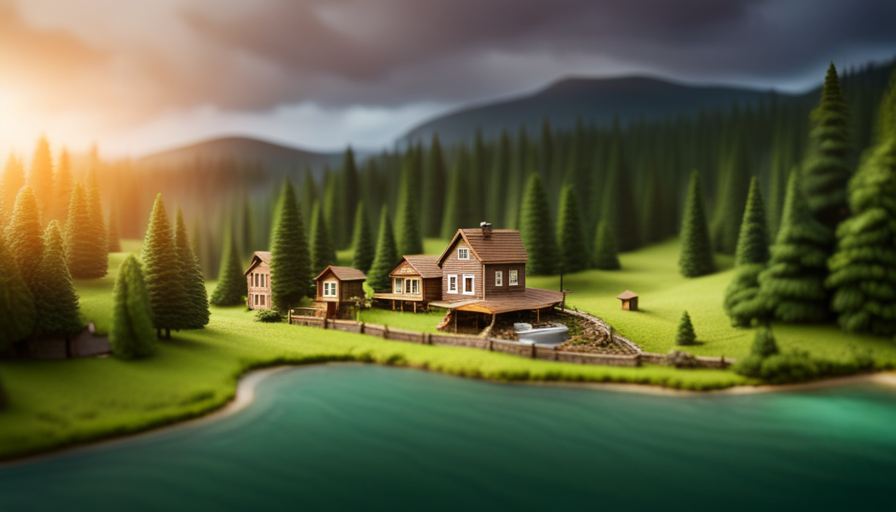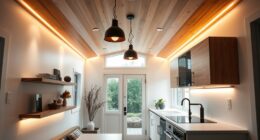Have you ever wondered about the smallest size a tiny house can actually be? Get ready to be amazed, because in this article, I will explore the dimensions of a 200 sq ft tiny house.
Yes, you heard that right – 200 sq ft! Now, you may be thinking, ‘How on earth can anyone live in such a small space?’ But trust me, living in a tiny house is not as daunting as it may seem. In fact, it can be quite liberating.
In this article, I will delve into the length, width, and height of a 200 sq ft tiny house, as well as discuss the impact of design choices and provide tips on making the most of this compact living space.
So, if you’re curious about tiny house living, keep reading to discover the wonders of living small.
Key Takeaways
- A 200 sq ft tiny house is the size of a small studio apartment
- Space-saving techniques and multi-purpose furniture are crucial for maximizing functionality
- Utilizing vertical space through shelves and cabinets provides valuable storage
- Design choices such as width, height, lighting, and color greatly impact the functionality and perception of space in a tiny house
Understanding Tiny House Dimensions
A 200 sq ft tiny house is about the size of a small studio apartment. In order to make the most of the limited space, exploring space-saving techniques is crucial. Every inch counts, so it’s important to think creatively and find innovative ways to maximize functionality.
One popular technique is using multi-purpose furniture that can serve multiple functions. For example, a sofa can double as a bed, or a table can fold up against the wall when not in use.
Additionally, utilizing vertical space is key. Installing shelves or cabinets that reach up to the ceiling can provide valuable storage space for items that are not used frequently.
Another important aspect to consider when designing a 200 sq ft tiny house is the layout. By exploring different layout options, you can maximize the flow of the space and ensure that each area serves a specific purpose.
With careful planning and strategic design choices, even a small 200 sq ft tiny house can feel spacious and functional.
Transitioning into the next section, let’s explore the layout options in more detail.
Exploring the Layout Options
Imagine walking into your dream home, a cozy, compact space that feels like a perfectly organized puzzle waiting to be solved. As you step inside, you’re immediately struck by the clever layout and space-saving techniques that have been employed to maximize functionality.
Every nook and cranny has been carefully considered to ensure that no space is wasted. One of the key aspects of exploring the layout options in a 200 sq ft tiny house is the use of multi-purpose furniture. From convertible sofas that double as beds to tables that can be folded away when not in use, these pieces are essential for maximizing the limited square footage.
Additionally, built-in storage solutions are strategically placed throughout the house to keep belongings organized and out of sight. Another important consideration is the flow of the space. By carefully arranging the furniture and fixtures, the layout can be optimized to create a sense of openness and spaciousness. This may involve using light-colored walls and mirrors to reflect natural light and visually expand the space.
Exploring space-saving techniques and maximizing functionality are critical when designing a 200 sq ft tiny house. By utilizing multi-purpose furniture and strategic layout planning, it’s possible to create a comfortable and efficient living space.
With the layout options considered, let’s now examine the length of a 200 sq ft tiny house.
Examining the Length of a 200 sq ft Tiny House
As you delve into the analysis of a 200 sq ft tiny house, it’s crucial to examine the overall length, considering every inch of available space. When exploring space-saving techniques, maximizing functionality becomes paramount.
In a tiny house, every square foot matters, and careful consideration must be given to the length of the structure. To make the most out of a 200 sq ft tiny house, various layout options can be explored.
One approach is to have an open floor plan, where the living area, kitchen, and bedroom seamlessly flow into one another. This eliminates the need for walls and creates a sense of spaciousness. Additionally, utilizing multi-functional furniture, such as a sofa that converts into a bed or a dining table that folds down when not in use, can further maximize the limited space.
Another technique to consider is incorporating storage solutions that utilize vertical space. By utilizing wall-mounted shelves, hanging organizers, and built-in cabinets, you can effectively utilize the height of the tiny house and free up valuable floor space.
Considering the importance of width and height, it’s essential to carefully plan the layout of a 200 sq ft tiny house. By exploring space-saving techniques and maximizing functionality, you can create a comfortable and efficient living space within the limited dimensions.
Considering the Importance of Width and Height
Hey there, when you’re thinking about the dimensions of your 200 sq ft tiny house, don’t forget to consider the importance of width and height. These two factors play a crucial role in maximizing space in a small dwelling.
Let’s dive deeper into why they are so important:
-
Width: The width of your tiny house can greatly impact the functionality and flow of the space. A narrow width can make it difficult to fit essential features like a kitchen or bathroom comfortably. On the other hand, a wider width allows for more flexibility in layout and makes the house feel more open and spacious.
-
Height: The height of your tiny house is equally important. A taller ceiling can create a sense of openness and prevent the space from feeling cramped. It also allows for the inclusion of lofted areas, which can be used for sleeping or storage, effectively utilizing vertical space.
By carefully considering the width and height of your tiny house, you can optimize the layout and maximize every square foot.
In the next section, we will analyze the impact of design choices on the overall functionality and livability of your tiny house.
Analyzing the Impact of Design Choices
Exploring the design choices can profoundly impact the functionality and livability of your compact home. When it comes to a 200 sq foot tiny house, every inch matters, and making the right design choices can maximize the use of limited space.
One important aspect to consider is space optimization. By carefully planning the layout, you can ensure that every area serves a purpose and that there is no wasted space. For example, incorporating built-in storage solutions such as hidden cabinets or under-bed storage can help keep clutter at bay. Additionally, choosing multi-purpose furniture, like a dining table that can double as a desk or a sofa that can convert into a bed, can significantly increase the usability of your tiny home.
Another design choice to consider is the use of light and color. Opting for light-colored walls and ample windows can create an illusion of space and make the tiny house feel more open and airy. Furthermore, incorporating smart lighting solutions, such as recessed lights or adjustable lamps, can help maximize the functionality of each area and create different moods based on your needs.
When it comes to a 200 sq foot tiny house, the design choices you make play a crucial role in how well you can utilize the limited space. By optimizing every square inch and carefully considering the layout, storage solutions, and lighting, you can create a compact home that feels spacious and functional. Learning from real-life examples of well-designed tiny houses can provide valuable insights and inspiration for your own space.
Learning from Real-Life Examples
When it comes to understanding the impact of design choices in tiny homes, there’s no better way than to learn from real-life examples. That’s why I highly recommend touring 200 sq ft tiny homes and hearing from actual tiny house owners.
By experiencing these spaces firsthand and listening to the insights of those who live in them, we can gain a detailed and precise understanding of the design choices that work best and the ones that may not be as effective.
Touring 200 sq ft Tiny Homes
Take a step inside a 200 sq ft tiny house and you’ll be amazed at how every square inch is maximized, like a well-oiled machine. Touring small spaces has taught me the art of utilizing vertical and multi-functional storage solutions.
From cleverly designed loft beds to hidden compartments in furniture, these tiny homes offer a plethora of ideas for maximizing storage. The kitchen area often features compact appliances and creative shelving systems, while the bathroom may have foldable fixtures and innovative space-saving techniques.
Living in a 200 sq ft tiny house requires careful organization and a minimalist mindset, but it can also be incredibly rewarding. As we transition into hearing from tiny house owners, it’s clear that these small spaces truly provide a unique and efficient way of living.
Hearing from Tiny House Owners
Step into the world of tiny house owners and discover the secrets to their unique and efficient way of living. Hearing from tiny house owners firsthand provides valuable insight into the challenges and triumphs of maximizing storage space in a 200 sq ft tiny house.
These individuals have mastered the art of organization, utilizing every nook and cranny to its fullest potential. From clever built-in shelving to hidden compartments, they have found innovative solutions to store their belongings without sacrificing comfort or style. It’s fascinating to hear their stories and learn from their experiences.
As we delve into their world, we gain a deeper understanding of the thoughtfulness and creativity required to make the most of a 200 sq ft tiny house. Transitioning into the next section, let’s explore some tips for optimizing space in these compact dwellings.
Tips for Making the Most of a 200 sq ft Tiny House
To truly treasure a tiny 200 sq ft tiny house, try these terrific tips for making the most of your miniature abode.
-
Maximizing Storage: In a small space like a 200 sq ft tiny house, storage is key. Get creative with your storage solutions by utilizing vertical space with shelving units and hooks. Invest in furniture that doubles as storage, such as ottomans with hidden compartments or beds with built-in drawers. Use under-bed storage containers and hanging organizers to make the most of every inch.
-
Creating Multi-Functional Spaces: With limited square footage, it’s important to make every space in your tiny house serve multiple purposes. Consider using a fold-out table or a wall-mounted desk that can be tucked away when not in use. Use curtains or sliding doors to create separate areas within the tiny house, such as a bedroom or workspace. Choose furniture that can be easily reconfigured to adapt to different needs.
-
Organizational Systems: Keeping your tiny house organized is essential for maximizing space. Invest in storage bins, baskets, and dividers to keep items neatly organized. Use labels to easily identify the contents of each storage container. Implement a regular decluttering routine to prevent your tiny house from becoming cluttered and overwhelming.
By following these tips, you can make the most of your 200 sq ft tiny house by maximizing storage, creating multi-functional spaces, and implementing effective organizational systems. These strategies will help you create a functional and comfortable living space despite the limited square footage.
In the next section, we will address common concerns and misconceptions about living in a tiny house.
Addressing Common Concerns and Misconceptions
One misconception about living in a small space is that it must feel cramped and uncomfortable. While it’s true that a 200 sq foot tiny house is compact, there are many ways to address common concerns and misconceptions.
One concern is the lack of storage space. However, with careful planning and the use of multifunctional furniture, it’s possible to maximize every inch of the house. Installing built-in shelves and utilizing vertical space can help alleviate storage issues.
Another concern is the lack of privacy. However, clever design choices such as using curtains or room dividers can create separate areas within the tiny house.
Additionally, the misconception that a small space cannot accommodate guests is easily debunked. With the use of pull-out beds or convertible furniture, hosting friends and family is not a problem.
These common concerns and misconceptions can be overcome with thoughtful design and organization. By addressing these concerns, living in a 200 sq foot tiny house can be comfortable and enjoyable.
Considering the benefits of living small, such as reduced expenses and a simplified lifestyle, it becomes clear that size doesn’t matter when it comes to creating a cozy and functional home.
Considering the Benefits of Living Small
Living in a compact space offers numerous advantages, providing a chance to simplify one’s lifestyle and reduce expenses while still enjoying a cozy and functional home.
The benefits of living small are plentiful. With limited square footage, there’s less space to accumulate unnecessary belongings, leading to a clutter-free environment that promotes a sense of calmness and organization.
Additionally, a smaller house requires less maintenance and cleaning, freeing up more time for leisure activities or pursuing personal interests.
Furthermore, the reduced size of a tiny house translates into lower utility bills and overall expenses, allowing individuals to save money or allocate it towards other priorities.
Of course, it’s important to consider the downsides of living in a compact space as well. Limited storage can pose a challenge, requiring creative solutions to maximize the available space. Privacy can also be a concern, especially if multiple people share the tiny house. However, with careful planning and thoughtful design, these downsides can be mitigated or even turned into opportunities for creative solutions.
Living in a small space offers numerous benefits, including simplified living, reduced expenses, and a cozy atmosphere. While there are downsides to consider, they can be overcome with careful planning and creative thinking.
Taking the leap into tiny house living opens up a world of possibilities and allows individuals to embrace a simpler, more sustainable lifestyle.
Transitioning into the next section, it’s important to explore the various design options available for tiny houses to ensure a functional and personalized living space.
Conclusion and Next Steps
Now that I’ve explored the numerous benefits and downsides of compact living, it’s time to dive into the exciting world of designing my own personalized and functional space.
One of the most appealing aspects of tiny house living is the opportunity to explore alternative options and get creative with limited space. With a 200 square foot tiny house, there are endless possibilities for layout and design. I can maximize storage by utilizing vertical space with built-in shelving and cabinets. Multi-functional furniture, such as a sofa that can be converted into a bed, can also help optimize the use of space.
However, it’s important to consider potential challenges that may arise when designing a small space. Limited square footage means I’ll need to carefully prioritize what is essential and make efficient use of every inch. It may require some compromises and creative problem-solving, but with careful planning and attention to detail, I can create a cozy and functional home that meets my needs.
Frequently Asked Questions
What are the advantages of choosing a tiny house over a traditional home?
Choosing a tiny house over a traditional home offers numerous advantages. Firstly, tiny house living promotes a simpler and more minimalist lifestyle, allowing individuals to prioritize experiences over material possessions.
Additionally, the reduced size of a tiny house translates to lower costs for construction, maintenance, and utilities.
Moreover, tiny house communities provide a sense of belonging and support, fostering a strong sense of community and social connections.
Embracing the advantages of tiny house living can lead to a more fulfilling and sustainable lifestyle.
How can I maximize storage space in a 200 sq ft tiny house?
To maximize storage space in a 200 sq ft tiny house, I become a master of organization. I utilize every nook and cranny, making use of vertical space with shelves and hooks. I employ clever storage solutions, like multi-functional furniture with hidden compartments. By decluttering and strategically arranging my belongings, I create a sense of spaciousness.
With a little creativity and smart choices, I ensure that every inch of my tiny house is optimized for storage and organization.
Are there any legal restrictions or zoning regulations for living in a tiny house?
There may be legal restrictions and zoning regulations that govern living in a tiny house. It’s important to research and understand these rules as they vary depending on the location.
Legal restrictions can include minimum square footage requirements, permits, and building codes. Zoning regulations may dictate where a tiny house can be placed, such as in designated areas or as an accessory dwelling unit.
Compliance with these regulations is crucial to ensure a lawful and safe living arrangement.
What are some common challenges or difficulties that come with living in a tiny house?
Living in a tiny house presents numerous challenges, particularly when it comes to organization. With limited space, it’s crucial to find clever storage solutions and maximize every inch.
Maintaining tidiness is a constant battle, as clutter can quickly accumulate. Additionally, the lack of privacy can be difficult to navigate, especially when living with others.
However, by carefully planning and prioritizing organization, these challenges can be overcome, making tiny house living a rewarding and fulfilling experience.
How much does it typically cost to build a 200 sq ft tiny house?
Typically, building a 200 sq ft tiny house costs around $25,000 to $50,000, depending on various factors such as location, materials used, and customization. The cost of materials accounts for the majority of the expenses, including lumber, insulation, roofing, and fixtures.
Additionally, the construction timeline for a 200 sq ft tiny house can range from a few weeks to a few months, depending on the complexity of the design and the availability of labor.
Conclusion
After analyzing the dimensions and layout options of a 200 sq ft tiny house, it’s clear that living small can have its advantages.
One interesting statistic to note is that despite its compact size, a well-designed tiny house can provide all the necessary amenities and even accommodate a small family comfortably.
With careful planning and creative design choices, a 200 sq ft tiny house can offer a cozy and sustainable living space that promotes a simpler and more environmentally-friendly lifestyle.
Hi, I’m Emma. I’m the Editor in Chief of Tiny House 43, a blog all about tiny houses. While tree houses are often associated with childhood, they can be the perfect adult retreat. They offer a cozy space to relax and unwind, surrounded by nature. And since they’re typically built on stilts or raised platforms, they offer stunning views that traditional homes simply can’t match. If you’re looking for a unique and romantic getaway, a tree house tiny house might just be the perfect option.










